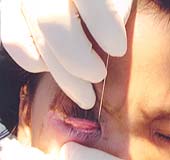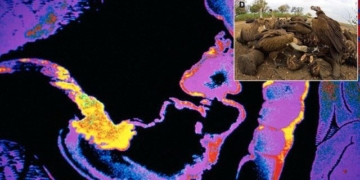Since birth, baby T.T.A.T, residing in Ben Tre, has experienced continuous tearing accompanied by discharge from both eyes. Initially, the family thought this was a common occurrence for newborns and assumed it would resolve itself over time…
 |
| Customary practices for children with constant tearing (Photo: N.C) |
However, by the time T. reached 5 months old, the tearing had not stopped. It was then that the family decided to take T. for a medical check-up. At the Ho Chi Minh City Eye Hospital, T. was diagnosed with excessive tearing. Due to a prolonged infection, the tear duct had become blocked. Although doctors attempted to flush the duct twice, the tear flow had not returned to normal. T. is still under observation, and if necessary, further probing or surgery to create a new tear drainage pathway may be required.
Blocked Tear Duct System
Dr. Vo Thi Chinh Nga from the Pediatric Department of Ho Chi Minh City Eye Hospital reported that recently, the number of children with excessive tearing seeking treatment has significantly increased, averaging about 30 children per day (previously only 15-20 children per day). Among eye conditions in children, this is the second most common issue after conjunctivitis.
According to Dr. Nga, the symptoms of excessive tearing include frequent or intermittent tearing, which can affect one or both eyes. Tearing may be accompanied by discharge, mucus, or crusting. The causes of this condition include congenital blockage of the tear duct system, injury causing duct rupture due to falls while playing, or foreign particles impacting the conjunctiva or cornea. Recently, the hospital has seen many cases of excessive tearing due to scratches from cats and dogs.
Treatment Depends on the Cause
Dr. Nga explained that the treatment method depends on the underlying cause of the condition. For children experiencing tearing from birth, saline drops may suffice. However, if there is significant discharge, antibiotic drops along with pressure massage of the tear duct may be necessary. If the condition persists, the doctor will consider flushing and probing the tear duct. This procedure is typically performed when the child is at least 3 months old, and the child will undergo flushing a few times accompanied by pressing on the tear duct. If a blockage is detected during flushing, doctors will proceed with probing the duct. In cases of tear duct fistula, surgery will be required to close the fistula. Children arriving at the hospital with swollen eyes or lacrimal sac abscesses will require drainage of the abscess, followed by surgery to create a connection between the lacrimal sac and the nasal cavity. After about 6 months, the silicone tube used during surgery will be removed, and most patients will return to normal function.
Early Treatment: Avoiding Serious Risks
Dr. Nga emphasized that if the condition of excessive tearing is not treated promptly, it can lead to acute lacrimal sac inflammation, lacrimal sac abscess, and in severe cases, sepsis, meningitis, or even death. Therefore, she advises that newborns exhibiting discharge, redness, or especially frequent tearing should be taken to specialized facilities for examination and treatment. It is crucial not to self-medicate with eye drops, as this can lead to complications such as glaucoma or corneal ulcers, resulting in vision loss. Dr. Nga stated that early detection and timely treatment of this condition can simplify the treatment process significantly.
|
Associate Professor, Dr. Le Minh Thong – Head of the Oculoplastic and Neuro-ophthalmology Department, Ho Chi Minh City Eye Hospital: Adults Can Also Be Affected Excessive tearing does not only occur in children; adults can also be affected. There are numerous causes for blockage of the tear duct system, including previous conditions like trachoma, rhinitis, sinusitis, and nasal trauma. On average, the Oculoplastic and Neuro-ophthalmology Department performs surgery for about 30 patients with excessive tearing each month. In adults, probing the tear duct is generally ineffective for treating duct blockage. Therefore, patients should avoid more than three probing attempts, as excessive probing can damage the tear duct and reduce the effectiveness of future surgeries. Currently, the optimal treatment method is the creation of a new pathway to allow tears to drain into the nasal cavity. |
Thuy Duong


















































